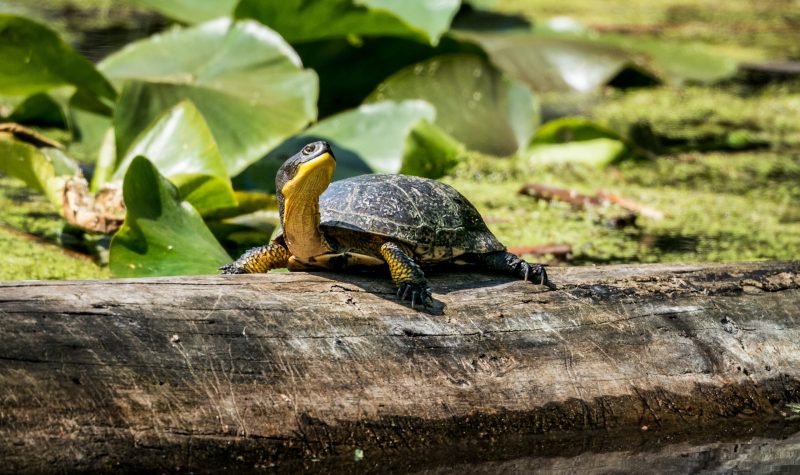A local environmentalist wants to see urban design and wildlife work together.
There are currently over 500 plant and animal species that are considered at risk in Canada, according to the Canadian Wildlife Federation. The City of Ottawa is home to over 60 of them, including plants and trees, insects, mammals, birds and aquatic species.
Sahar Seif, who is currently working towards her master’s degree in environmental sustainability from the University of Ottawa, says the city needs to rethink the infrastructure of new developments to protect species at risk and other wildlife.
Seif works seasonally at Rideau Valley Wildlife Sanctuary as a wildlife rehabilitator. She says that urban design and environmental conservation go hand-in-hand.
“So I would argue that… there's a lot of large gaps that so many are trying to fill with protecting species,” says Seif. “But understanding habitat is difficult in a world that is quickly losing its greenspaces at the rate that we are going.”
In April 2019, Ottawa declared a climate emergency. Ottawa introduced a Climate Change Master Plan in January 2020, which included a vow to “apply a climate lens to the new Official Plan and its supporting documents.” Additionally, the city has implemented legislation to protect Ottawa’s natural ecology, such as the Tree Protection By-law of 2020.
But there are structural considerations in urban design that environmental scholars such as Seif believe Ottawa and other major municipalities have overlooked.
“Regarding design, a lot of modern design seems to be covered by glasses…that are very reflective,” says Seif. “We're so accustomed to having these really reflective, clean windows, but when in fact…that is the worst thing for birds and migratory birds, especially when they're coming in.”
Ottawa does have some guidelines for building more sustainable developments, but their objectives mainly focus on creating energy-efficient homes and structures that will contribute less to the pollution of surrounding areas.
Seif says some of the species most at-risk of harm from new developments in Ottawa are avians such as birds and bats, who look for high-up places such as roofs and window sills to build their homes.
“Having designers include things like…creating a habitat for them, would perhaps be very beneficial to…the oncoming birds and whatever things that could be visiting on a migratory basis,” says Seif.
Seif added that the status of aquatic species in Ottawa is compromised due to the development of the Ottawa River watershed.
According to Ottawa Riverkeeper, a local environmental group, there are several species at risk that call Ottawa’s waters home, including types of fish, frogs, turtles and birds. Human influence on the watershed, such as the construction of dams, municipal and industrial wastewater run-off, and the development of the shoreline have all contributed to the destruction of natural habitats along the Ottawa River.
Seif says turtles are frequent visitors to the Rideau Valley Wildlife Sanctuary, as their habitats are actively being destroyed.
“Turtles, by default, are very much at risk around areas such as Ottawa because we are primarily a swamp and wet sort of habitat,” says Seif. “Right now in the sanctuary, we have a Blanding's turtle baby that came to us because he had fallen in a pool. We have snapping turtles. We also have painted turtles. And on… occasion, we have a turtle called 'map turtle'… and they are threatened, as most turtles are in Ontario.”
Rideau Valley Wildlife Sanctuary also receives a high volume of small mammals, such as raccoons, skunks, squirrels and groundhogs. Seif says many of them are injured or killed trying to cross urban highways and roads, while others are reported as a nuisance by homeowners and require relocation.
“And there's nothing that is in place to compensate for… all the roads that are killing off all these creatures,” says Seif. “And they just keep building things that increase the risk. So for sure, this is a major problem.”
Wildlife crossings are a potential solution to protecting animals from getting hit by cars. Banff National Park in Alberta has received acclaim for their series of corridors built under roads, allowing for the safe passage of local wildlife. However, there are few elsewhere in Canada.
Ottawa’s Wildlife Strategy doesn’t include a mandate for the construction of wildlife crossings, but it does provide for the maintenance of municipal culverts, a part of Ottawa’s larger drainage system. There are 52 culverts in Ottawa, which are large, tunnel-like corridors built under roads, railways, and embankments, permitting the passage of wildlife.
Seif says that in addition to implementing wildlife-friendly infrastructure throughout the city, there is a need for greater education regarding the proper treatment of wild animals. She says there is a general lack of knowledge among urban residents about the wildlife living among them, which can lead to dire consequences for some species.
“Unfortunately, people… call and say, ‘this animal is on my property, and I don't want it here,’” says Seif. “Or, ‘I don't see the mom, what do I do?’ So a lot of the time, we refer them to the website, which explains the exact protocols to follow in a situation.”
Seif says a common misconception people have is that baby rabbits found on their own are orphaned or abandoned. In fact, rabbits don’t burrow, but make their nests on the ground’s surface, according to the Ontario SPCA. It’s therefore common to stumble upon a nest of baby rabbits when the mother is out, but the SPCA says they shouldn’t be touched. Baby rabbits are extremely vulnerable without their mothers, according to Seif, who says she often sees people bringing in baby rabbits to the sanctuary.
“So by doing that, you're making a death sentence for that animal,” says Seif.
Seif wants to encourage residents to educate themselves about their wild neighbours, as well as to think about how their habitats can coexist with our own.
For more information about local wildlife, visit ottawa.ca.
Listen to the CHUO interview with Seif below:


